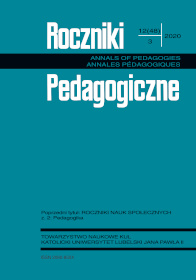Youth and Video Games – Motives, Emotions and Problems Related to Gaming
Main Article Content
Abstract
This article analyzes the phenomenon of using computer games by young people. The aim of the own study was to learn and analyze the motives, emotions and problems related to the involvement of youth in gaming. The research method used was the diagnostic survey and the technique used was collective interview. The study involved 316 students from primary school (from the fifth to seventh grade) and junior high school (second and third class) from the Warmian-Masurian and Kuyavian-Pomeranian Voivodships.
The results of the study show that students motivate to play, above all, the desire to entertain and enjoy playing, but games are also a way for them to counteract boredom. Participants also pointed out utilitarian motives related to games, such as the opportunity to acquire new competences or learn new skills. Young people experience mainly positive emotions while playing, but a significant number of students indicate that they feel anger during and after playing. The participants were able to characterize the person who, in their opinion, uses games excessively.
Article Details
References
Bednarek, J., Andrzejewska, A. (red.) (2009). Cyberświat ‒ możliwości i zagrożenia. Warszawa: Wydawnictwo Akademickie Żak.
Blinka, L., Škařupová, K., Ševčíková, A., Wölfling, K., Müller, K.W., Dreier, M. (2015). Excessive internet use in European adolescents: what determines differences in severity? International Journal Of Public Health, 60(2), 249-256.
Counter-Strike: Global Offensive PC. (b.d.). GRYOnline.Pl, https://www.gry-online.pl/gry/counter-strike-global-offensive/z02d7c#pc (dostęp: 20.02.2018).
Festl, R., Scharkow, M., Quandt, T. (2013). Problematic computer game use among adolescents, younger and older adults. Addiction, 108, 592-599.
Izdebski, P. (2019). Internet i gry internetowe. Warszawa: Wydawnictwo Naukowe PWN.
King, D.L., Delfabbro, P.H. (2016). The Cognitive Psychopathology of Internet Gaming Disorder in Adolescence. Journal Of Abnormal Child Psychology, 44(8), 1635-1645. doi:10.1007/ s10802-016-0135-y.
Kuss, D.J. (2013). Internet gaming addiction: Current perspectives. Psychology Research and Behavior Management, 6, 125-137.
Kuss, D.J., Griffiths, M.D. (2012). Online gaming addiction in children and adolescents: A review of empirical research. Journal of Behavioral Addictions, 1(1), 3-22.
Lemmens, J.S., Valkenburg, P.M., Gentile, D.A. (2015). The Internet Gaming Disorder Scale. Psychological Assessment, 27(2), 567-582.
Makaruk, K., Włodarczyk, J., Wójcik, S. (2013). Metodologia badania EU NET ADB. Dziecko krzywdzone. Teoria, badania, praktyka, 12(1), 7-11.
Müller, K., Janikian, M., Dreier, M., Wölfling, K., Beutel, M., Tzavara, C., ... Tsitsika, A. (2015). Regular gaming behavior and internet gaming disorder in European adolescents: results from a cross-national representative survey of prevalence, predictors, and psychopathological correlates. European Child & Adolescent Psychiatry, 24(5), 565-574.
Poznaj świat Grand Theft Auto V. Komputer Świat.https://www.komputerswiat.pl/aktualnosci/inne/poznaj-swiat-grand-theft-auto-v/30qctp0 (dostęp: (18.09.2013).
Rehbein, F., Kliem, S., Baier, D., Mößle, T., Petry, N.M. (2015). Prevalence of internet gaming disorder in German adolescents: diagnostic contribution of the nine DSM-5 criteria in a state- wide representative sample. Addiction, 110(5), 842-851. doi:10.1111/add.12849.
Rowicka, M. (2018). E-uzależnienia. Teoria, profilaktyka, terapia. Warszawa: Krajowe Biuro do Spraw Przeciwdziałania Narkomanii oraz Fundacja Praesterno.
Strzyżewski, M. (2017). Skąd wziął się Counter-Strike? Gobalny fenomen ma już ponad półtorej dekady. Komputer Świat, https://www.komputerswiat.pl/gamezilla/aktualnosci/skad-wzial-sie-counter-strike-gobalny-fenomen-ma-juz-ponad-poltorej-dekady/82t3cn3 (dostęp: 17.02.2017).
van Rooij, T., Daneels, R., Liu, S., Anrijs, S., Van Looy, J. (2017). Children’s Motives to Start, Continue, and Stop Playing Video Games: Confronting Popular Theories with Real-World Observations. Current Addiction Reports, 4, 323-332.
World Health Organization (2019). International statistical classification of diseases and related health problems (11th ed.), https://icd.who.int/.
Wójcik, S. (2013). Gry online – korzystanie i nadużywanie wśród młodzieży. Wyniki badania EU NET ADB. Dziecko Krzywdzone. Teoria, Badania, Praktyka, 12(1), 24-26.

